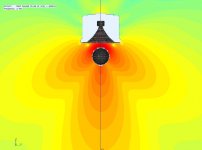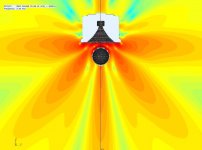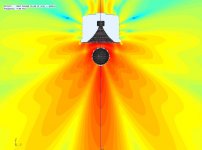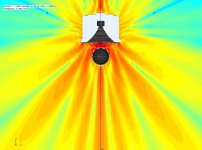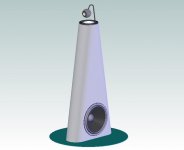Hi Don, thanks so much for all of this!
So looks like the HF is a mess of nodes with the sphere, but better than nothing i guess and the sphere does aid the dispersion somewhat. I assume the ceiling reflections will help a bit as well.
I had a look into machining the Duevel style wooden horn on the CNC and its just a bit of a hassle at this stage, so will stick with the spheres. I can always machine it later on if i want.
I think I've narrowed down the drivers, will order in the next few days.
Woofer - Aurum Cantus AC-180F1 7" Woofer - only concern is that Qts is still on the low side but should be ok
Compression driver - Selenium D220Ti 1" Titanium Horn Driver 8 Ohm 1-3/8"-18
Horns - Selenium HL14-25 1" Exponential Horn 45x45 1-3/8"-18 TPI and Dayton Audio H08RW 8" Round Waveguide 1-3/8"-18 TPI (will try the horn within horn reflector)
I'll also grab a USB measurement mic.
I saw the Dayton USB speaker analyzer ( Dayton Audio DATS V2 Computer Based Audio Component Test System ) - Is this any good? useful? I have a scope etc handy but if this save significant time and effort than perhaps worth a look.
So looks like the HF is a mess of nodes with the sphere, but better than nothing i guess and the sphere does aid the dispersion somewhat. I assume the ceiling reflections will help a bit as well.
I had a look into machining the Duevel style wooden horn on the CNC and its just a bit of a hassle at this stage, so will stick with the spheres. I can always machine it later on if i want.
I think I've narrowed down the drivers, will order in the next few days.
Woofer - Aurum Cantus AC-180F1 7" Woofer - only concern is that Qts is still on the low side but should be ok
Compression driver - Selenium D220Ti 1" Titanium Horn Driver 8 Ohm 1-3/8"-18
Horns - Selenium HL14-25 1" Exponential Horn 45x45 1-3/8"-18 TPI and Dayton Audio H08RW 8" Round Waveguide 1-3/8"-18 TPI (will try the horn within horn reflector)
I'll also grab a USB measurement mic.
I saw the Dayton USB speaker analyzer ( Dayton Audio DATS V2 Computer Based Audio Component Test System ) - Is this any good? useful? I have a scope etc handy but if this save significant time and effort than perhaps worth a look.
John Krutke (Zaph Audio) measured the AC-180F-1 and did not get a low Qts (and AC's published specs tend to be not at all what you get). Go to this link and select this driver, then its T/S measurements.
Zaph|Audio
Paul
Zaph|Audio
Paul
Hi Don, thanks so much for all of this!
So looks like the HF is a mess of nodes with the sphere, but better than nothing i guess and the sphere does aid the dispersion somewhat. I assume the ceiling reflections will help a bit as well.
I had a look into machining the Duevel style wooden horn on the CNC and its just a bit of a hassle at this stage, so will stick with the spheres. I can always machine it later on if i want.
I think I've narrowed down the drivers, will order in the next few days.
Woofer - Aurum Cantus AC-180F1 7" Woofer - only concern is that Qts is still on the low side but should be ok
Compression driver - Selenium D220Ti 1" Titanium Horn Driver 8 Ohm 1-3/8"-18
Horns - Selenium HL14-25 1" Exponential Horn 45x45 1-3/8"-18 TPI and Dayton Audio H08RW 8" Round Waveguide 1-3/8"-18 TPI (will try the horn within horn reflector)
I'll also grab a USB measurement mic.
I saw the Dayton USB speaker analyzer ( Dayton Audio DATS V2 Computer Based Audio Component Test System ) - Is this any good? useful? I have a scope etc handy but if this save significant time and effort than perhaps worth a look.
John Krutke (Zaph Audio) measured the AC-180F-1 and did not get a low Qts (and AC's published specs tend to be not at all what you get). Go to this link and select this driver, then its T/S measurements.
Zaph|Audio
Paul
Thanks Paul, just had a look and it seems to be way off what the manufacturer stated.
Seems much harder than i thought to find an appropriate woofer.
Would you be able to suggest a woofer in a similar price range ($75 ish) and size (6-8 inch) that has a good low frequency extension, efficiency and a Qts that is suitable for a TL?
I had a look around the Madisound website and they have quite a range, but again not sure. Seems i'll still have to get the compression driver from parts express as well.
Thanks!
With CNC and 3D printing access maybe you could take on 'Plu-Tosh' (my one box concept for SL's Pluto+)?
One box concept for Pluto+: 'Plu-Tosh'
One box concept for Pluto+: 'Plu-Tosh'
Attachments
Hi Don, thanks so much for all of this!
So looks like the HF is a mess of nodes with the sphere, but better than nothing i guess and the sphere does aid the dispersion somewhat. I assume the ceiling reflections will help a bit as well.
Yes, but its surprising what gets filled in by the room when you spray it with an Omni.
I had a look into machining the Duevel style wooden horn on the CNC and its just a bit of a hassle at this stage, so will stick with the spheres. I can always machine it later on if i want.
I think I've narrowed down the drivers, will order in the next few days.
Woofer - Aurum Cantus AC-180F1 7" Woofer - only concern is that Qts is still on the low side but should be ok
Compression driver - Selenium D220Ti 1" Titanium Horn Driver 8 Ohm 1-3/8"-18
Horns - Selenium HL14-25 1" Exponential Horn 45x45 1-3/8"-18 TPI and Dayton Audio H08RW 8" Round Waveguide 1-3/8"-18 TPI (will try the horn within horn reflector)
The CD looks good. There's probably some optimal sphere distance and diameter for the chosen horn that might be quicker to find via experiment. I can't comment on the woofer as I'd need to run it through a HornResp model to get a working TL design. BTW you can probably suppress the woofer rear reflection better with a TL than a closed box like mine.
I'll also grab a USB measurement mic.
I saw the Dayton USB speaker analyzer ( Dayton Audio DATS V2 Computer Based Audio Component Test System ) - Is this any good? useful? I have a scope etc handy but if this save significant time and effort than perhaps worth a look.
A single USB mic (calibrated preferred) and REW is enough to make your measurements. REW can also do impedance measurements using a single resistor divider and a sound card headphone output. Useful for checking tuning.
I can't comment on the speaker measurement suite. I use the specs of what I bought and tune what I built.
P.S. I'll drop off this thread for 2wks cause I'll be on vacation. I'll catch up when I'm back.
Last edited:
P.S. I'll drop off this thread for 2wks cause I'll be on vacation. I'll catch up when I'm back.
Hey thanks so much for all the help! I'll keep chipping away at it so hopefully there will be something interesting for you to come back to.
Have a good vacation!
I used the SB Acoustics SB17NRX35-8 in a TL with very good results. You can use that same Zaph Audio link to get his T/S measurements which is what I used for my build. They are different from SB's published specs, but their differences are pretty much self compensating, like almost the same fS/Qts ratio and same Vas x fs2 product. Using either set of T/S values will result in virtually identical predicted performance in the same TL. [The differences between Aurum Cantas' specs and actual measurements are not self compensating.]
Paul
Paul
Thanks Paul, just had a look and it seems to be way off what the manufacturer stated.
Seems much harder than i thought to find an appropriate woofer.
Would you be able to suggest a woofer in a similar price range ($75 ish) and size (6-8 inch) that has a good low frequency extension, efficiency and a Qts that is suitable for a TL?
I had a look around the Madisound website and they have quite a range, but again not sure. Seems i'll still have to get the compression driver from parts express as well.
Thanks!
Just went to go buy the SB17NRX35-8 from madisound here - SB Acoustics SB17MFC35-8 6" Poly Cone Woofer but shipping to New Zealand is about $60, basically the same cost of the speaker.
Parts express have better shipping to NZ ($30) so I could get a more expensive woofer from them if there is something suitable.
Or is there something else from madisound that is worth it for a bit more money? (preferably 8 inch)
I've had a look on both parts express and madisound and there are a few that look good on paper (eg the Dayton 8" reference woofers) but again I cant find much data from others that have measured the speakers so I'm unsure.
Otherwise will just get the SB17NRX35-8
Parts express have better shipping to NZ ($30) so I could get a more expensive woofer from them if there is something suitable.
Or is there something else from madisound that is worth it for a bit more money? (preferably 8 inch)
I've had a look on both parts express and madisound and there are a few that look good on paper (eg the Dayton 8" reference woofers) but again I cant find much data from others that have measured the speakers so I'm unsure.
Otherwise will just get the SB17NRX35-8
The Dayton Audio RS180-4 works extremely well in a TL and I've used it on a couple of TL builds. But, it is a 4-ohm driver which you may not want to use. If you do use it I can share with you the T/S measurements (made by someone else) I used for the modeling/design.
Paul
Paul
Just went to go buy the SB17NRX35-8 from madisound here - SB Acoustics SB17MFC35-8 6" Poly Cone Woofer but shipping to New Zealand is about $60, basically the same cost of the speaker.
Parts express have better shipping to NZ ($30) so I could get a more expensive woofer from them if there is something suitable.
Or is there something else from madisound that is worth it for a bit more money? (preferably 8 inch)
I've had a look on both parts express and madisound and there are a few that look good on paper (eg the Dayton 8" reference woofers) but again I cant find much data from others that have measured the speakers so I'm unsure.
Otherwise will just get the SB17NRX35-8
The Dayton Audio RS180-4 works extremely well in a TL and I've used it on a couple of TL builds. But, it is a 4-ohm driver which you may not want to use. If you do use it I can share with you the T/S measurements (made by someone else) I used for the modeling/design.
Paul
Ok excellent, thanks for this.
I had initially wanted to go with 8 ohm for both the woofer and compression driver but is there any point to this? I was intending to create the cross overs digitally in DSP software in which case i dont think the impedance will matter, and parts express also carry the pre assembled cross overs that have selectable 4/8 ohm for the woofer if i wanted to go down this route.
The Dayton reference 7 (and 8) inch woofers come either 4 or 8 ohm anyway but just having a look and it seems the 4 ohms have higher efficiency and slightly higher Qts while the 8 ohms have a slightly lower Fs. Either way, plenty of options.
So it seems fine to mix drivers of different impedance in the same enclosure?
Thanks!
Just as a slight update on this,
Have purchased most parts for initial testing and just waiting for the stuff to be shipped to NZ.
-Beocreate AMP (with onboard DSP)
-Stainless spheres in 200mm, 150mm, 100mm, and 50mm size.
-Selenium D220Ti Compression driver and the 8" and 10" dayton round horn. Also grabbed a smaller selenium horn to test with. On second thoughts and doing some more reading, maybe a celestion CD might have been a better choice, but done now anyway.
-Dayton RS225P-4A woofer. Ended up going with the 4ohm paper woofer, response looked nicer. Also someone in NZ selling a pair of RS180P-4 woofers so i might grab those to test as well.
-Grabbed a UMM-6 mic for testing.
Also managed to get my hands on a Cambridge Audio Azure 340A integrated amp. Faulty but powers on fine (no output though). Have the schematic so shouldnt be too hard to fix. Was surprised to find it basically is a regular old gainclone when i opened it up.
I'll start with the tests when the parts arrive but was wondering, on face value is it possible i'll be more or less able to get full range (inc worthwhile bass) from only the two drivers, without using a sub? I'm hoping the TL on the woofer will help the bass, but i'm not sure how the crossing at around 2.5KHz will work out. And have read about people complaining about the high end extension on the D220Ti.
Will see
Have purchased most parts for initial testing and just waiting for the stuff to be shipped to NZ.
-Beocreate AMP (with onboard DSP)
-Stainless spheres in 200mm, 150mm, 100mm, and 50mm size.
-Selenium D220Ti Compression driver and the 8" and 10" dayton round horn. Also grabbed a smaller selenium horn to test with. On second thoughts and doing some more reading, maybe a celestion CD might have been a better choice, but done now anyway.
-Dayton RS225P-4A woofer. Ended up going with the 4ohm paper woofer, response looked nicer. Also someone in NZ selling a pair of RS180P-4 woofers so i might grab those to test as well.
-Grabbed a UMM-6 mic for testing.
Also managed to get my hands on a Cambridge Audio Azure 340A integrated amp. Faulty but powers on fine (no output though). Have the schematic so shouldnt be too hard to fix. Was surprised to find it basically is a regular old gainclone when i opened it up.
I'll start with the tests when the parts arrive but was wondering, on face value is it possible i'll be more or less able to get full range (inc worthwhile bass) from only the two drivers, without using a sub? I'm hoping the TL on the woofer will help the bass, but i'm not sure how the crossing at around 2.5KHz will work out. And have read about people complaining about the high end extension on the D220Ti.
Will see
Looks like you're well on the way. Looking forward to build pics, test results and listening impressions.
The Beocreate's built in DSP seems really interesting. They provided network access to the DSP which is a very smart feature. I use a Piano 2.1 with built in DAC DSP programmed via TI PurePath Raspberry Pi with Piano2.1 DAC DSP and Volumio2
The Beocreate looks like it uses an ADAU1451 programmed with SigmaStudio. If you need to do convolution based corrections (FIR filters) you'll need more memory but that can always be done in the RPI.
I found that I always gravitated to adding a subwoofer(s) for a number of reasons [control room modes, get 30ish Hz performance, avoid excess travel on the smaller 5"-8" woofers]. Nothing wrong with building your speaker and deciding later if you want to add sub(s). It might depend on the type of music you listen to.
The Beocreate's built in DSP seems really interesting. They provided network access to the DSP which is a very smart feature. I use a Piano 2.1 with built in DAC DSP programmed via TI PurePath Raspberry Pi with Piano2.1 DAC DSP and Volumio2
The Beocreate looks like it uses an ADAU1451 programmed with SigmaStudio. If you need to do convolution based corrections (FIR filters) you'll need more memory but that can always be done in the RPI.
I found that I always gravitated to adding a subwoofer(s) for a number of reasons [control room modes, get 30ish Hz performance, avoid excess travel on the smaller 5"-8" woofers]. Nothing wrong with building your speaker and deciding later if you want to add sub(s). It might depend on the type of music you listen to.
By suitable room, do you mean large?The HF will be the issue, as already pointed out. The sensitivity will also be low because you're driving 360deg and you need a suitable room for it.
Coincidence, I was looking at the Planets for the first time today
Yes, large enough to place the speakers and listening position at least 1m from the nearest wall to limit the min reflection time. Then spray the room and enjoy  .
.
I've tried a few shapes and drivers to get 360deg dispersion and ended up heading in the direction of the other Duevel omni models like the Belle Luna.
I've tried a few shapes and drivers to get 360deg dispersion and ended up heading in the direction of the other Duevel omni models like the Belle Luna.
Agreed, the dipole and omni probably have similar room requirements.
Stock spheres are easier to get and it does allow quick experimentation to try out the listening experience. I've been thinking about the sphere idea and whether it could be modified to improve it for the HF section. Something like "saturn" (center mount disc+sphere) with a smallish cone attached on the sphere's bottom. Custom making complex curve shapes manually is definitely more work, I'm not at the point where I can 3D print them.
Stock spheres are easier to get and it does allow quick experimentation to try out the listening experience. I've been thinking about the sphere idea and whether it could be modified to improve it for the HF section. Something like "saturn" (center mount disc+sphere) with a smallish cone attached on the sphere's bottom. Custom making complex curve shapes manually is definitely more work, I'm not at the point where I can 3D print them.
-Stainless spheres in 200mm, 150mm, 100mm, and 50mm size.
What spheres did you buy? Hollow ones are cheap, I was thinking could drill a hole and fill it with sand if need be?
What spheres did you buy? Hollow ones are cheap, I was thinking could drill a hole and fill it with sand if need be?
The spheres were probably the easiest part to buy out of all the components. I got some from china here - High Gloss Glitter Stainless Steel Ball Sphere Mirror Hollow Ball For Home Garden Decoration Supplies Ornament 19mm~300mm-in Decorative Balls from Home & Garden on Aliexpress.com | Alibaba Group but there are a number of sellers.
For mounting, im thinking i'll drill a hole and then inset a threaded rivet insert (rivnut) from the outside, and use that as a bolt/anchor point. The rivet nuts are very cheap.
I also thought about putting silicone sealant or some other adhesive inside to dull any resonance, but sand is a good idea.
- Home
- Loudspeakers
- Multi-Way
- Transmission line Omni speakers? Duevel Planets clone with transmission line?
